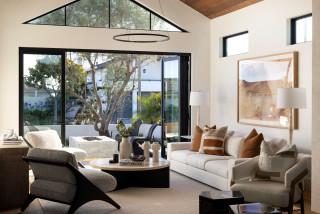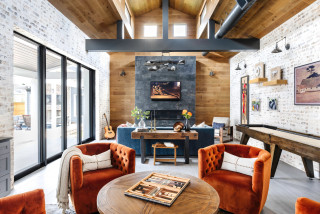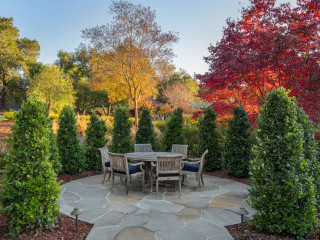
This article was originally published by a www.houzz.com . Read the Original article here. .

This article was originally published by a www.houzz.com . Read the Original article here. .

Designer tip. “Coating the walls, ceiling, and trim in a single paint color creates a cohesive, moody atmosphere while allowing key elements and finishes to take center stage,” Jensen says. “This unified approach adds depth and prevents the space from feeling overly busy or disjointed, with accent finishes providing just the right amount of contrast.”
New to home remodeling? Learn the basics
This article was originally published by a www.houzz.com . Read the Original article here. .

No one has to shiver for long while hastening into the house after soaking in this backyard hot tub in Los Angeles, thanks to its proximity to a doorway. The homeowner got rid of an unused swimming pool so landscape designer Catherine Bosler of Bosler Earth Design could install the hot tub and deck seen here, plus a covered lounge area and plenty of drought-tolerant plantings interwoven with pathways.
Being that the homeowner is British, Bosler looked to the English countryside for inspiration, infusing the space with softness, texture and color. Climbing jasmine grows on the cable railing panel between the deck and hot tub, adding greenery and an enticing fragrance to the space.
Extra-nice touch: The hot tub has built-in shelving along the side for towels and other necessities.
Read more about this project
This article was originally published by a www.houzz.com . Read the Original article here. .

In cold-winter regions, shut off any exterior water systems before cold weather hits. Then open the tap and drain the lines to prevent damage. Finally, disconnect any hoses. Do the same for any water lines leading to an outdoor kitchen.
At the same time, drain and clean any outdoor water features, such as fountains and ponds.
In warmer regions, check that your irrigation system is still working correctly. Repair or replace any sprinkler heads or drip system components as needed. Cut back on watering frequency as the weather cools. If rainfall is sufficient, turn the system off.
Even if you live in a warmer area, it’s a good idea to keep an eye on winter forecasts. Insulate exterior pipes and taps if a freeze is predicted, especially one that will last several days. Another option is to open the taps slightly to allow water to slowly drip out.
This article was originally published by a www.houzz.com . Read the Original article here. .

The “before” photo of this Seattle under-deck area shows how it was a hodgepodge of clutter. The homeowners wanted to create plenty of room where their young children could play, as well as space for dining and lounging.
Landscape designer Rebekah Rongo of SCJ Studio Landscape Architecture answered the call, and a sheltered area that wraps around a corner is part of the result. It’s designed for the kids, with a picnic table on one side, two bright red chairs on the other and a wraparound concrete step connecting the two. Tight-knot western red cedar walls warm up the space, create continuity in the yard’s design and conceal an easy-to-access storage area.
Note the light-colored under-decking too, to ensure that the spaces below stay dry on Seattle’s frequent drizzly days. Any water can drain through the permeable patio paver joints. After this photo was taken, the homeowners added a projection screen under the deck for movie nights.
Read more about this project
This article was originally published by a www.houzz.com . Read the Original article here. .

Take in the fall foliage on a hiking trail, at a local park or in your yard. Turn raking leaves from a chore into a chance to appreciate Mother Nature’s show. Once you have a pile of leaves, it might just be time to channel your inner child and jump in.
Rather than immediately bagging your leaves, consider using some or all of them as a natural mulch. You can spread a thin layer over your garden beds or lawn, allowing the leaves to decompose and add nutrients to the soil. Don’t make the layer too thick, especially over a lawn, as you don’t want to kill whatever might be growing underneath. Use a lawnmower or garden shredder to turn the leaves into smaller pieces.
5 Ways to Put Fall Leaves to Work in Your Garden
This article was originally published by a www.houzz.com . Read the Original article here. .
The style of existing windows and doors will have an impact on how easy it is to open up the space, Reader says. “Early uPVC versions often had a large amount of plastic frame, which reduces the area of glass and obstructs the view.”
Having said that, all the same tricks for connecting the spaces still stand, it’s just more difficult to create a direct visual link. “Create focal points that draw attention by using the same materials or styles inside and out,” Reader says. “That way, your eye will be drawn to the elements of the [landscape] that best link the two spaces.”
“Carefully consider the layout of the [yard] and the planting,” Fletcher says. “Maybe pick out an interesting tree or sculpture and make the most of it with lighting.”
“Painting the wall around the window white is another good way to minimize any distraction from the view,” Jones says.